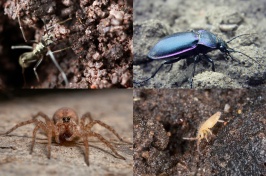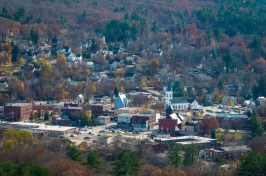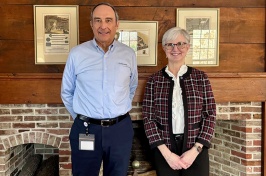University of New Hampshire Awarded $24 Million to Build Solar Wind Sensors for NOAA

The sensors UNH will be building will monitor space weather. Auroras are the most visible manifestation of space weather which can affect the electric power grid and other key infrastructure on Earth. (Photo credit: Anton Petrus/Getty Images)
DURHAM, N.H. — The University of New Hampshire was awarded $24.3 million by NASA, on behalf of the National Oceanic and Atmospheric Administration (NOAA), to build sensors for a high-priority alert system that will monitor the effects of space weather and the solar wind — caused by explosions on the sun — for potential interruptions to key technology like satellite communications, electric power grids and GPS systems.
“We are extremely excited to play a critical role in the nation's space weather alert system,” said Lynn Kistler, professor of physics and astronomy and director of UNH’s Space Science Center. “This allows us to use our scientific expertise to help address vital national safety interests and build on UNH’s long history of scientific and operational missions, expanding the range of the UNH Space Science Center’s strong proficiency and skill in space instrumentation.”
As part of the Solar Wind Plasma Sensor contract, UNH will develop and build two sensors for the Lagrange 1 Series project to monitor the solar wind — a supersonic flow of hot particles known as plasma, from the sun. The sensors at L1 will help identify and give a heads up warning of any concerns in about 100 minutes for slower events and about ten minutes for faster events.
This data will be used in both real time for NOAA’s Space Weather Prediction Center alert system, which issues forecasts, warnings and alerts that help mitigate any potential issues caused by space weather, as well as be available to the scientific community to study the response of the Earth's environment to space weather events.
“While the data may be used in space weather impact studies, this is an operational mission to help raise the alarm if any large-scale solar wind structures, such as coronal mass ejections, passing the L1 point are considered dangerous,” Toni Galvin, research professor and director of N.H. Space Grant Consortium. “Because of that, the instrument requirements are more stringent, and they have to be able to measure the most extreme conditions with high accuracy, because those are the conditions that can cause the most potential harm to technology.”
UNH will oversee the design, development, fabrication, integration, testing and evaluation of the sensors. The researchers will also support the launch, supply and maintain the instrument ground support equipment and support post-launch mission operations at the NOAA Satellite Operations Facility in Suitland, Maryland. UNH will work with subcontractor Johns Hopkins Applied Physics Laboratory where researchers there will focus on the electronics for the instruments. The project is expected to take nine years to complete.
The sensors will measure solar winds — a continuous stream of particles, mainly protons and electrons in a state known as a plasma, flowing outward from the Sun. The measurements will be used to characterize coronal mass ejections, corotating interaction regions, interplanetary shocks and high-speed flows associated with coronal holes. The measurements will also include observing the bulk ion velocity, ion temperature and density and derived dynamic pressure.
“UNH is a leader in the interdisciplinary fields of both space weather research and space and satellite instrument design,” said Marian McCord, senior vice provost for research, economic engagement and outreach. “We are proud to have been selected by NASA to support NOAA in the effort to understand space weather to protect our infrastructure from its potentially crippling effects.”
UNH’s Space Science Center has a long-standing heritage with solar wind instrumentation and a strong engineering and science background with in situ instrumentation for both operational and scientific missions. Those include the delivery of two solar wind instruments for the NASA Solar Terrestrial Relations Observatory (STEREO) mission, a major hardware contribution to the ESA Solar Orbiter Solar Wind Plasma Analyser (SWA) Heavy Ion Sensor (HIS), as well as involvement in the Energetic Heavy Ion Sensor (EHIS) for the Geostationary Operational Environmental Satellite (GOES-R) Program and work for the magnetometer (MAG) instrument for the Space Weather Follow On L1 (SWFO-L1) mission.
NASA and NOAA oversee the development, launch, testing, and operation of all the satellites in the L1 Series project. NOAA is the program owner that provides funds and manages the program, operations, and data products and dissemination to users. NASA and commercial partners develop, build and launch the instruments and spacecraft on behalf of NOAA.
The UNH team includes Lynn Kistler, project director; Antoinette Galvin, deputy project director; and Christopher Mouikis, ground software and data validation lead.
PHOTOS FOR DOWNLOAD
LINK: https://www.unh.edu/unhtoday/sites/default/files/solar_flare_nasa_may_10_2024.jpg
CAPTION: NASA’s Solar Dynamics Observatory (SDO) captured solar flares from the sun in May of 2024. Solar flares—an intense burst of radiation, or light, from the sun—are the solar system’s most powerful explosive events and can interrupt technology on Earth including power grids and GPS systems.
CREDIT: NASA/SDO
LINK: https://www.unh.edu/unhtoday/sites/default/files/aurora-borealis-high-tension-power-lines.jpg
CAPTION: The sensors UNH will be building will monitor space weather. Auroras are the most visible manifestation of space weather which can affect the electric power grid and other key infrastructure on Earth.
CREDIT: Anton Petrus/Getty Images
LINK: https://www.unh.edu/unhtoday/sites/default/files/swo-lagrange-points-diagram.jpg
CAPTION: Lagrange Points of the Earth-Sun system (not drawn to scale).
CREDIT: NOAA
LINK: https://www.unh.edu/unhtoday/sites/default/files/cornoal-mass-ejections-aug_31_cme_4_panel.jpg
CAPTION: One of the measurements collected by the new sensors will be used to characterize coronal mass ejections seen here in four different extreme ultraviolet wavelengths (335, 171, 131, and 304 angstroms) captured by SDO, STEREO and SOHO.
CREDIT: NASA/Goddard Space Flight Center.
About UNH
The University of New Hampshire inspires innovation and transforms lives in our state, nation and world. More than 16,000 students from 50 states and 87 countries engage with an award-winning faculty in top-ranked programs in business, engineering, law, health and human services, liberal arts and the sciences across more than 200 programs of study. A Carnegie Classification R1 institution, UNH partners with NASA, NOAA, NSF, and NIH, and received over $250 million in competitive external funding in FY24 to explore and define the frontiers of land, sea and space.
Latest News
-
Research Finds Rural Americans Carry Heavy Burden Accessing Social Security Benefits and InformationMarch 27, 2025
-
March 25, 2025
-
March 17, 2025
-
March 12, 2025
-
February 19, 2025













































